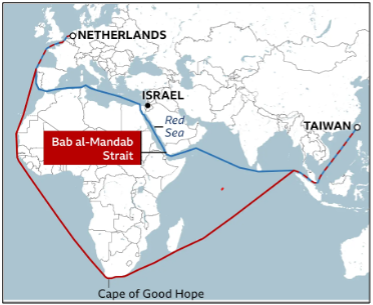Terror Threat to Primary Supply Chain
The events of the last month have again drawn the world’s attention to the vulnerability of a major supply chain and maritime trade choke point to terrorism. Not since the Suez Canal was closed following the 6 day war between Israel and her neighbours in 1967 have so many ships trading between Asia and Europe been re-routed via the Cape of Good Hope. Between 1986 and 1985 the Canal was of course closed to all shipping but now it is Iranian financed and armed Houthi terrorists based in Yemen that are creating havoc by launching attacks, primarily aimed at container shipping when transiting the 20 mile wide Bab al Mandab Strait at the southern end of the Red Sea, an area which hosts close to 12% of world trade including 30% of container traffic on a daily basis. The stated objective is to punish vessels having trading links with Israel, however the range of vessels being targeted goes well beyond this.
The transit from Asia to Europe via the Cape adds around 3,500 nautical miles or 8-9 days to the sailing time of a container ship making 17-18 knots. Before the current disruption, container rates were soft on account of excess ocean carrier capacity which was already resulting in cancelled sailings ahead of the Chinese New Year. For the ocean carriers, the additional sailing time has generated the short term benefit of soaking up excess tonnage while also resulting in the rate for a 40’ container (FEU) from Asia to Europe doubling to now stand at around $4,500. When the saving of the cost of a Suez transit is also taken into account (around US$700,000 each way) the additional fuel cost (around US$350,000 each way) of sailing via the Cape does not look too bad. Unfortunately, this ignores vessel capital and operating cost, a variable depending on the capacity of the vessel, however a decent large container ship can easily carry a price tag of $100,000 per day.
At the end of the day, under reasonable market conditions most carriers will argue that despite the high cost of War Risk Insurance Premiums, Suez is their best option, in particular when taking account of supply chain efficiency and levels of customer service. Added to this is the reality that contrary to the 1967-75 closure of Suez, Southern Africa does not have the infrastructure or supply chains to provide bunkers to service a short-term spike in container vessels passing the Cape. The pressure is therefore on Asian, European and U.S. East Coast bunker suppliers to find the additional volumes of 7-800 tonnes per vessel. Thankfully, the oil markets are currently slack and prices manageable.
Over 400 container vessels with a capacity of nearly 6 million TEU have so far diverted from the Red Sea. For context there is currently around 27 million TEU of global vessel carrying capacity.
The impacts of events in the Red Sea are also being felt elsewhere. As we wrote in our September 2023 newsletter, the loss of around 30% of Panama Canal transit capacity due to drought conditions has resulted in the diversion of several Asia to North America sailings to Suez. Being now diverted away from Suez is resulting in delays and higher costs as Asian shippers scramble to switch their supply chains back to North American west coast ports and already, the potential inflationary impacts are being debated.

USS Dwight D. Eisenhower during Suez Canal transit
In December 2023, the United States established “Operation Prosperity Guardian”, to provide naval protection to shipping in the Red Sea. The initial 10 partners in this are the United States led by the aircraft carrier USS Dwight D. Eisenhower, the UK led by the destroyer HMS Diamond, Canada, France, Italy, Spain, the Netherlands, Norway, Bahrain and the Seychelles. Denmark, Greece and Sril Lanka have announced plans to lend support with naval assets while others are dithering. India has announced that they will be there in force but will retain operational independence. Unfortunately, there is a notable lack of direct regional support while Russia and China, both permanent members of the UN Security Council are silent.
Of course, not just any warship will do to combat the threat. Modern well armed warships and aircraft (and/or helicopters) having the ability to shoot down Iranian sourced drones, anti-ship cruise missiles and anti-ship ballistic missiles are needed. An unwanted complication is the arrival of the 55 year old Iranian frigate Alborz in the Red Sea. Her role is unclear but for sure it is not to offer protection to shipping.
Despite warnings to the Houthis in Yemen that a continuation of attacks on shipping will result in retaliation, the attacks are ongoing at this time. While western nations are keen not to pour fuel on the current fire in the Middle East, for sure this direct challenge to peaceful commerce cannot be allowed to continue. On a personal note, when transiting the Suez Canal on November 4, 2023, aboard the cruise ship Celebrity Edge, our southbound convoy was led by USS Dwight D. Eisenhower and her escort vessels. Little did we realize that she would be called upon to fulfill such a key role in the current troubled times.
Feature Image Courtesy BBC

